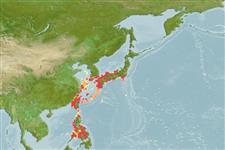>
Eupercaria/misc (Various families in series Eupercaria) >
Cepolidae (Bandfishes) > Cepolinae
Etymology: Acanthocepola: Greek, akantha = thorn + Latin, cepulla, cepa = onion.
More on authors: Temminck & Schlegel.
Environment: milieu / climate zone / depth range / distribution range
Ecología
marino; salobre demersal; rango de profundidad 3 - 50 m (Ref. 90102). Tropical; 37°N - 10°N, 119°E - 141°E (Ref. 56297)
Western Pacific: Indonesia to the Philippines; north to Japan, south to Australia.
Tamaño / Peso / Age
Maturity: Lm ? range ? - ? cm
Max length : 40.0 cm TL macho / no sexado; (Ref. 559)
Identified by the spaced series of pupil-sized red spots along upper sides (Ref. 48635).
Inhabits the shallowest water, compared to other cepolids. Lives on muddy substrates, deep as well as in shallow protected estuaries (Ref. 48635). Caught by dredge, but not valued as food fish (Ref. 559, 637).
Life cycle and mating behavior
Maturities | Reproducción | Spawnings | Egg(s) | Fecundities | Larva
Allen, G.R. and M.V. Erdmann, 2012. Reef fishes of the East Indies. Perth, Australia: Universitiy of Hawai'i Press, Volumes I-III. Tropical Reef Research. (Ref. 90102)
IUCN Red List Status (Ref. 130435)
Threat to humans
Harmless
Human uses
Herramientas
Special reports
Download XML
Fuentes de Internet
Estimates based on models
Preferred temperature (Ref.
123201): 17.2 - 28.6, mean 21.5 °C (based on 66 cells).
Phylogenetic diversity index (Ref.
82804): PD
50 = 0.5625 [Uniqueness, from 0.5 = low to 2.0 = high].
Bayesian length-weight: a=0.00513 (0.00222 - 0.01187), b=2.82 (2.61 - 3.03), in cm total length, based on LWR estimates for this (Sub)family-body shape (Ref.
93245).
Nivel trófico (Ref.
69278): 3.4 ±0.4 se; based on size and trophs of closest relatives
Resiliencia (Ref.
120179): Medio, población duplicada en un tiempo mínimo de 1.4-4.4 años (Preliminary K or Fecundity.).
Fishing Vulnerability (Ref.
59153): Low to moderate vulnerability (30 of 100).
